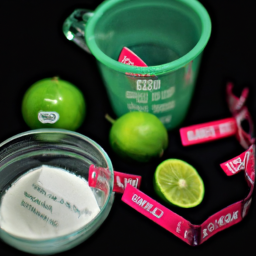I absolutely love adding lime juice to my food and drinks, but squeezing it by hand can be quite a hassle. That’s why I invested in a juicer – it makes the process so much easier and faster.
In this article, I’ll walk you through the steps on how to juice a lime in a juicer, from selecting the right juicer to troubleshooting common issues.
Firstly, it’s important to choose a juicer that’s suitable for citrus fruits. Look for a model with a cone-shaped attachment specifically designed for squeezing lemons, limes, and oranges.
Next, choose limes that are firm and heavy for their size, with bright green skin and no soft spots. Rinse them under cold water and pat them dry before cutting them in half.
With these simple steps, you’re ready to start juicing!
Key Takeaways
- Investing in a juicer with a cone-shaped attachment for citrus fruits makes juicing quick and effortless.
- Look for firm, heavy limes with bright green skin and no soft spots for maximum juice extraction.
- Apply firm pressure while juicing and roll limes on a hard surface before cutting to release more juice.
- Fresh lime juice is a popular ingredient in many recipes, including cocktails, marinades, dressings, and limeade.
Choose the Right Juicer
To get the most juice out of your lime, you’ll want to make sure you’ve got the right juicer on hand! There are different types of juicers, but for citrus fruits like limes, you’ll want to use a manual or electric citrus juicer.
These juicers are specifically designed to extract the maximum amount of juice from citrus fruits.
When using a citrus juicer, it’s important to cut the lime in half and place it cut side down on the reamer. Apply pressure and twist the lime back and forth to release the juice.
With an electric citrus juicer, simply place the lime half on the reamer and press the lever down to extract the juice. The key is to press firmly, but not too hard as to avoid bitterness from the pith.
With the right juicer and proper technique, you’ll get the most juice out of your limes in no time!
Now, let’s move on to the next step and select and prepare your limes.
Select and Prepare Your Limes
First things first, you might be thinking that selecting and preparing limes is a hassle, but trust me, it’s worth it for the delicious flavor it’ll add to your drink.
When selecting limes, look for ones that are firm and heavy for their size, with smooth and shiny skin. Avoid limes with soft spots or blemishes, as they may be overripe and not as flavorful.
It’s also important to properly store your limes before juicing them. Keep them in a cool, dry place away from direct sunlight, and avoid storing them with other citrus fruits as they can cause each other to spoil faster.
By selecting and storing your limes correctly, you’ll ensure that the juice you get from them is of the highest quality.
Now that you’ve got your limes, it’s time to set up your juicer and start juicing!
Set Up Your Juicer
Once you have your firm and heavy limes with smooth and shiny skin, it’s time to get your juicer ready for action.
Juicing a lime in a juicer is a simple process, but it requires some knowledge of juicing techniques and types of juicers. There are different types of juicers available in the market, such as centrifugal juicers, masticating juicers, and citrus juicers. For juicing limes, you need a citrus juicer that’s specifically designed for extracting juice from citrus fruits.
To set up your juicer, plug it in and place the container underneath the spout. Then, position the lime half on the juicer’s cone with the cut side facing down. Gently press the lime down onto the cone and turn it clockwise to extract the juice. You can also tilt the lime slightly or rotate it back and forth to ensure maximum juice extraction.
Once you have extracted the juice, remove the lime half and repeat the process with the remaining limes.
Juicing your limes is an important step in preparing your recipe. To ensure the best flavor and quality, it’s recommended to use fresh and ripe limes. Juicing your limes using a juicer is an easy and efficient way to extract the juice without any mess or hassle.
Now that your juicer’s set up, let’s move on to the next section about how to juice your limes to get the most out of them.
Juice Your Limes
When preparing a recipe that calls for lime juice, it’s important to note that one medium lime yields approximately 2 tablespoons of juice. Fresh lime juice is a popular ingredient in many recipes, including marinades, dressings, cocktails, and desserts. Lime juice not only adds a tangy flavor to your dish, but it also provides a significant amount of vitamin C, which can boost your immune system and improve your skin health.
To juice your limes, first cut them in half using a sharp knife. Then place each half on the juicing cone of your juicer, cut side down. Turn the juicer on and press the lime down with a little force, moving it back and forth to extract all the juice. Repeat with the remaining limes until you have the desired amount of juice for your recipe.
Collect the juice by pouring it into a measuring cup or a small bowl.
Collect the Juice
When I collect lime juice, I always use a measuring cup or bowl to ensure accuracy. This is important because the amount of lime juice needed can greatly affect the taste of the dish.
After juicing the limes, I strain the juice to remove any pulp or seeds. This results in a smooth and flavorful juice.
Use a Measuring Cup or Bowl
Using a measuring cup or bowl can save you time and frustration when juicing a lime in a juicer, so give it a try! Here are some measuring techniques that can help you get the most juice out of your lime:
- Cut the lime in half crosswise, so you can easily extract the juice from both halves.
- Hold the lime half over the measuring cup or bowl, cut-side down, and squeeze it firmly with your hand.
- Use a spoon to scrape out any remaining juice and pulp from the lime half.
- Repeat with the other half of the lime.
Using a measuring cup or bowl also helps you choose the right lime variety for your recipe, as you can measure the exact amount of juice you need. Whether you’re using a Persian or a Key lime, make sure it’s fresh and ripe for the best flavor.
Now that you’ve collected your lime juice, it’s time to strain it to remove any pulp or seeds.
Let’s move on to the next step: strain the juice.
Strain the Juice
Now that you’ve got your freshly squeezed lime nectar, it’s time to give it a proper strain to ensure a smooth and pulp-free experience. To do this, I recommend using a strainer for lime juice. You can use a fine mesh strainer or a cheesecloth to get rid of any leftover pulp or seeds.
Pour the freshly squeezed lime juice through the strainer and into a measuring cup or bowl. Use a spoon or spatula to press down on the pulp and extract as much juice as possible. The result should be a perfectly smooth and refreshing lime juice that’s perfect for cocktail making.
To take this up a notch, you can add a few drops of mint extract or a splash of sparkling water to the lime juice for a fun twist on a classic drink.
Now that you have your strained and perfectly fresh lime juice, it’s time to store it properly to ensure it stays fresh for as long as possible.
Store the Juice
To get the most out of your lime juice, make sure to properly store it in an airtight container in the fridge. Here are a few things to keep in mind when storing lime juice:
- Use a glass or plastic container with a tight-fitting lid to prevent air from getting in and oxidizing the juice.
- Make sure the container is clean and dry before pouring in the juice.
- Label the container with the date you made the juice so you know when to use it by.
- Store the juice in the refrigerator for up to one week.
Properly storing lime juice will help preserve its freshness and flavor, making it a great addition to any recipe.
Once you’ve stored your juice, it’s important to clean your juicer to maintain its longevity and prevent any buildup.
Clean Your Juicer
Maintaining the longevity of your juicer is crucial, so it’s important to clean it properly after each use. To start, unplug the machine and disassemble the components.
Rinse the removable parts under running water and use a soft brush to scrub away any remaining pulp or residue. Be sure to pay extra attention to the small crevices where mold can grow.
For a deeper clean, mix a solution of water and white vinegar and soak the parts for 10-15 minutes before rinsing thoroughly. To prevent mold growth, make sure to dry each component completely before reassembling the juicer. Use a clean towel or let the parts air dry overnight.
Another cleaning tip is to avoid using harsh chemicals or abrasive materials that can damage the machine. Instead, opt for gentle cleaning solutions and soft brushes.
By following these cleaning tips, your juicer will continue to produce fresh, tasty juice for years to come.
Once your juicer is clean and ready to use, you may encounter some common issues such as clogged filters or unevenly extracted juice. Don’t worry, troubleshooting these problems is easier than you think. Simply refer to the next section for some helpful tips and tricks.
Troubleshoot Common Issues
So, I’ve been juicing for a while now and I’ve encountered a few common issues that might happen to you too. One of them is clogging or stalling of the juicer, which can be frustrating and time-consuming to deal with.
Another issue is low juice yield, which can be disappointing when you expect to get a lot of juice from your fruits and vegetables.
In this subtopic, we’ll discuss these issues and provide some troubleshooting tips to help you get the most out of your juicer.
Clogging or Stalling
If your juicer is clogging or stalling while juicing a lime, you may need to adjust the speed and push the lime through the chute with a little more force. To prevent clogs, make sure to remove any seeds or tough parts of the lime before juicing. Also, cut the lime into smaller pieces that can fit easily into the juicer.
Improving efficiency can also help prevent clogs and stalling. Try alternating between juicing a lime and then adding a piece of a softer fruit or vegetable, such as a cucumber or pear, to help push any remaining lime juice through the juicer.
Additionally, make sure to clean the juicer regularly to prevent any buildup of pulp or debris that can cause clogs. With these tips, you should be able to juice limes with ease and enjoy fresh, delicious lime juice in your recipes.
If you’re still experiencing issues, the next subtopic will cover low juice yield and how to address it.
Low Juice Yield
To get the most out of your lime, you’ll want to make some adjustments to your juicing technique. One common reason for low juice yield is using limes that aren’t ripe enough. It’s best to choose limes that’re fully ripe and have a slight give when gently squeezed. This’ll ensure that the lime is at its juiciest and ready to be used in your recipe.
Another technique for maximizing juice yield is to cut the lime in half crosswise, rather than lengthwise. This exposes more of the lime’s flesh to the juicer’s reamer, allowing for more juice to be extracted. Additionally, it’s important to apply firm pressure to the lime as it’s being juiced. This’ll help the juicer extract as much juice as possible.
With these adjustments, you’ll be able to get the most out of your lime and ensure that your recipe has the freshest and most vibrant flavor possible.
Now that you know how to adjust your juicing technique for the best yield, let’s explore some creative tips and variations to enhance the flavor and presentation of your lime juice.
Tips for Juicing Limes
When juicing limes, a helpful tip is to roll them on a hard surface before cutting them in half, similar to how a baker rolls dough to make it more pliable. This technique helps to break down the fibers and release more juice from the lime.
Another way to get the most out of your lime is to use a citrus reamer or a fork to extract the remaining juice from the pulp. By doing so, you can maximize the yield and ensure that you get the most juice from your lime.
When it comes to lime juice recipe ideas, there are plenty of creative options to choose from. You can add fresh lime juice to your favorite cocktails, marinades, dressings, or even use it to make a refreshing limeade.
One of my favorite ways to enjoy fresh lime juice is to mix it with honey and hot water for a soothing and immune-boosting tea. Whatever your preference may be, the key to a delicious lime juice is to use fresh, high-quality limes and to juice them properly.
Enjoy Your Fresh Lime Juice!
Now that you’ve learned some tips for juicing limes, it’s time to enjoy your fresh lime juice! There are so many benefits to drinking lime juice, from aiding digestion to boosting your immune system with its high vitamin C content. Plus, it’s a versatile ingredient that can be used in a variety of recipes, from cocktails to marinades.
To make the most of your fresh lime juice, here are some ideas to try:
- Make a classic margarita with tequila, lime juice, and a splash of orange liqueur.
- Mix lime juice with honey and hot water for a soothing morning drink.
- Add lime juice to your favorite salad dressing for a zesty kick.
- Make a marinade for grilled chicken or fish with lime juice, garlic, and olive oil.
- Stir lime juice into guacamole for a bright and tangy flavor.
So go ahead and juice those limes! With these simple ideas, you’ll be able to enjoy the benefits of lime juice in a variety of delicious ways.
Frequently Asked Questions
How long does freshly squeezed lime juice last in the fridge?
Freshly squeezed lime juice can last up to a week in the fridge. To extend its shelf life, store it in an airtight container and add a pinch of salt or a splash of vodka as preservative methods. Use within 3 days for best flavor.
Can you use a blender instead of a juicer to make lime juice?
Using a blender to juice citrus fruits is possible, but it will result in a thicker, pulpier consistency compared to using a juicer. For a smoother juice, use a juicer. However, adding a splash of sparkling water can make the thicker juice more enjoyable.
How many limes do you need to make a cup of lime juice?
To make a cup of lime juice, I use 8-10 limes. Lime juice ratios vary depending on personal preference, but I prefer a 1:1 ratio of lime juice to water. For the freshest flavor, I recommend hand juicing the limes using a citrus juicer or reamer.
Is it necessary to remove the peel before juicing the lime?
It’s not necessary to remove the peel before juicing a lime, but it can impact the flavor. The peel can add bitterness, so use a zester to add some of the peel’s essential oils for a brighter taste.
Can you use bottled lime juice instead of fresh lime juice in recipes?
While bottled lime juice is convenient, fresh lime juice offers superior flavor and health benefits. Look for limes that are heavy for their size, with smooth, shiny skin. Roll them on a hard surface before juicing to release more juice.
Conclusion
Well, there you have it, folks! Juicing limes in a juicer is a simple and easy process that can be done in no time. As someone who enjoys a good margarita, I can tell you that the quality and freshness of the lime juice you use can really make all the difference in the world.
It’s like a painter choosing the right colors for their canvas. Just as a painter carefully selects their colors, we must carefully choose our ingredients to create the perfect drink.
And with these tips and tricks, you can create a masterpiece of your own. So, go ahead and give it a try. Enjoy the refreshing taste of freshly squeezed lime juice in your favorite cocktail or dish.
Cheers to quality ingredients and delicious drinks!
Ilana has been a vegan for over 10 years. She originally made the switch for health reasons, but soon found herself becoming more and more passionate about the ethical and environmental implications of a vegan lifestyle. Ilana is the author of The Graceful Kitchen, a blog all about veganism. She loves to cook up delicious and nutritious vegan meals, and share her recipes with others who are interested in leading a cruelty-free life. Ilana is also a strong advocate for using whole foods as the foundation of a healthy diet, and believes that going vegan is one of the best ways to achieve this.










